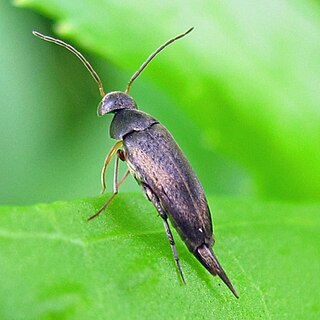
Lythrum salicaria or purple loosestrife is a flowering plant belonging to the family Lythraceae. It should not be confused with other plants sharing the name loosestrife that are members of the family Primulaceae. Other names include spiked loosestrife and purple Lythrum. This herbaceous perennial is native to Europe and Asia, and possibly Australia.

Dermestidae are a family of Coleoptera that are commonly referred to as skin beetles. Other common names include larder beetle, hide or leather beetles, carpet beetles, and khapra beetles. There are over 1,800 species described.

The Tenebrionoidea are a very large and diverse superfamily of beetles. It generally corresponds to the Heteromera of earlier authors.

The common furniture beetle or common house borer is a woodboring beetle originally from Europe but now distributed worldwide. In the larval stage it bores in wood and feeds upon it. Adult Anobium punctatum measure 2.7–4.5 millimetres (0.11–0.18 in) in length. They have brown ellipsoidal bodies with a prothorax resembling a monk's cowl.

Cleridae are a family of beetles of the superfamily Cleroidea. They are commonly known as checkered beetles. The family Cleridae has a worldwide distribution, and a variety of habitats and feeding preferences.

The Mordellidae are a family of beetles commonly known as tumbling flower beetles for the typical irregular movements they make when escaping predators, or as pintail beetles due to their abdominal tip which aids them in performing these tumbling movements. Worldwide, there are about 1500 species.

Polydrusus formosus is a species of broad-nosed weevil belonging to the family Curculionidae, subfamily Entiminae.
Mordellistena aethiops is a species of beetle in the genus Mordellistena of the family Mordellidae discovered in 1882. Its larvae feed on the stems of Silphium laciniatum.
Mordellistena angustiformis is a species of beetle in the family Mordellidae. It was described in 1937 by Eugene Ray from Puerto Rico.
Mordellistena arida is a beetle in the genus Mordellistena of the family Mordellidae. It is more commonly known as the Tumbling Flower Beetle. It was described in 1862 by John Lawrence LeConte.
Mordellistena barberi is a species of beetle in the family Mordellidae. It was described in 1937 by Eugene Ray from Puerto Rico.
Mordellistena danforthi is a species of beetle in the family Mordellidae. It was described in 1937 by Eugene Ray from Puerto Rico.

Mordellistena liturata is a beetle in the genus Mordellistena of the family Mordellidae. It was described in 1845 by Frederick Ernst Melsheimer. It is found in gardens and is just over 4 millimetres (0.16 in) in length and has a 1 millimetre (0.039 in) tail.
Mordellistena pallipes, the pale-legged tumbling flower beetle, is a species of beetle from the family Mordellidae. It has an extensive distribution across the northern United States and southern Canada, with its native range stretching east-to-west from New Hampshire to Minnesota, and north-to-south from Ontario to Virginia.
Mordellistena rayi is a species of beetle in the family Mordellidae. It was first described as Mordellistena humeralis in 1937 by Eugene Ray from Puerto Rico, but this name was preoccupied by Mordellistena humeralis(Linnaeus, 1758), and the replacement name Mordellistena rayi was created by Karl Ermisch in 1965.
Mordellistena unicolor is a species of beetle in the genus Mordellistena of the family Mordellidae. It was described by John Lawrence LeConte in 1862. Larvae feed on gall tissue of the goldenrod gall fly and often consume the fly larvae within the gall as well.

Mordellistena variegata, the tumbling flower beetle, is a species of beetle in the genus Mordellistena in the family Mordellidae. It was described by Johan Christian Fabricius in 1798.
Mordellistena varietas is a species of beetle in the family Mordellidae. It was described in 1937 by Eugene Ray from Puerto Rico.

Agriotes sputator is a species of click beetle, commonly known as the common click beetle. The adult beetle is brown and inconspicuous, and the larvae live in the soil and are known as wireworms. They are agricultural pests that devour the roots and underground parts of many crops and other plants.

Hypomeces pulviger, also known as the gold-dust weevil or green weevil, is a species of beetle in the true weevil family. The adult weevil can reach a length of about 14 mm (0.6 in) and is covered with iridescent green or yellowish-green dust-like scales all over the body. This species can be found in India, tropical Southeast Asia, and the Philippines. Both the larvae and adults are crop pests. The larvae live in and pupate in the soil, feeding on living plant roots. The adult weevils are long-lived, doing damage to foliage, and sometimes defoliating young bushes and nursery trees.










